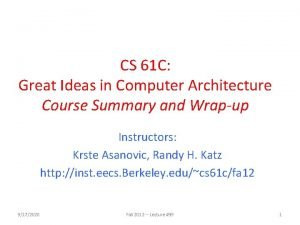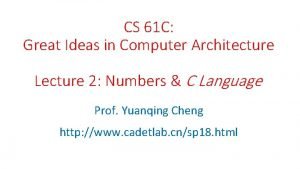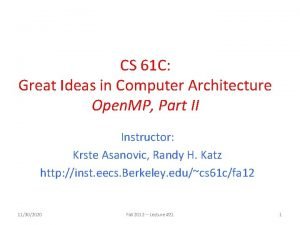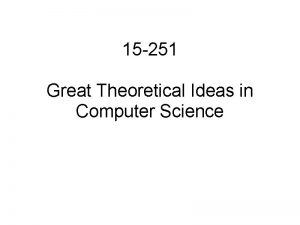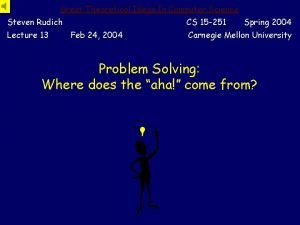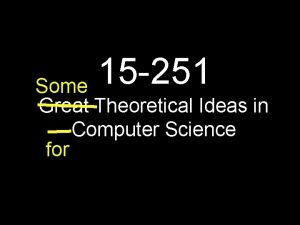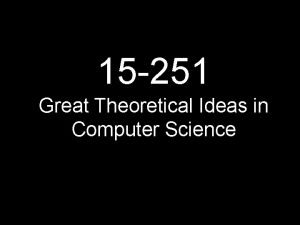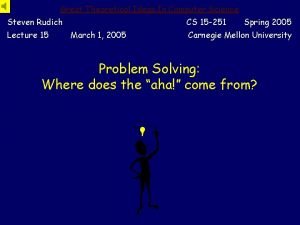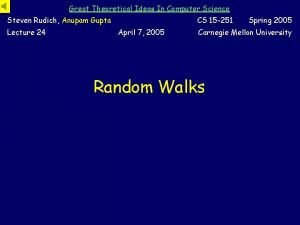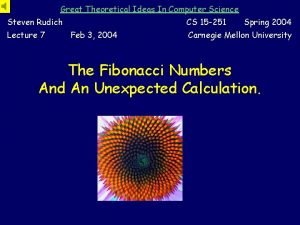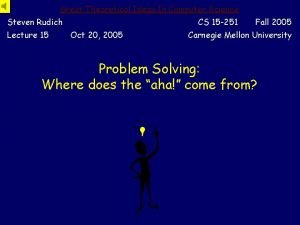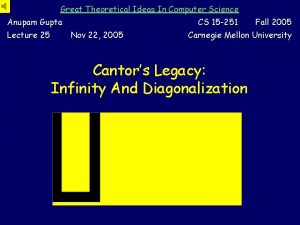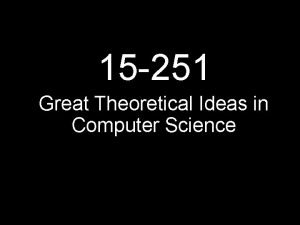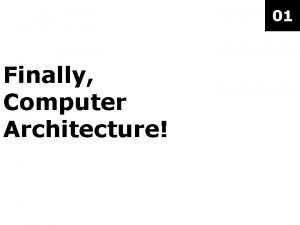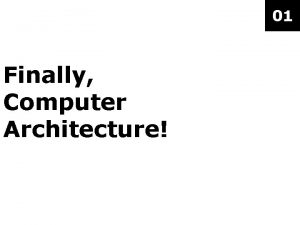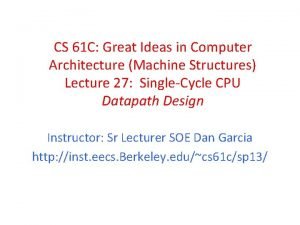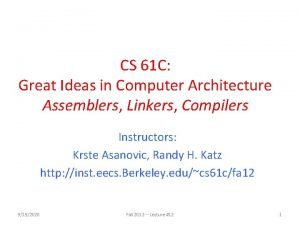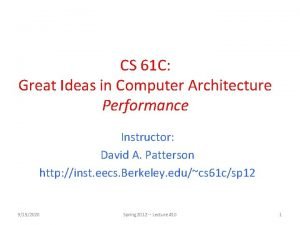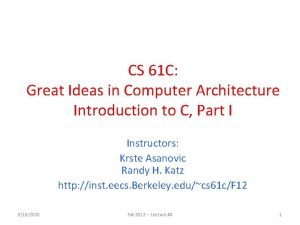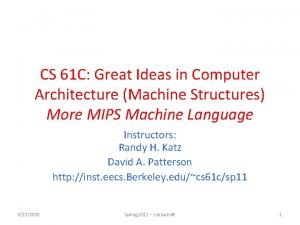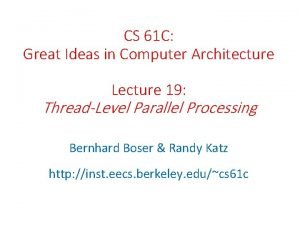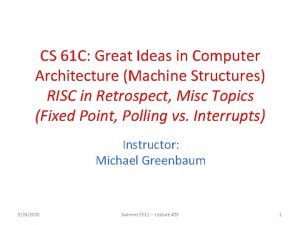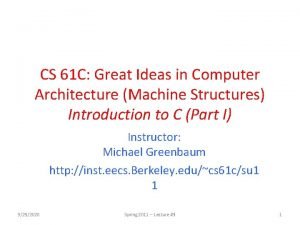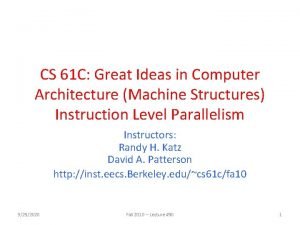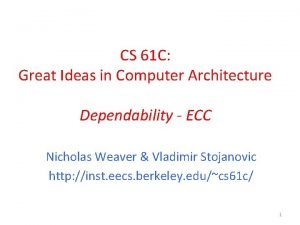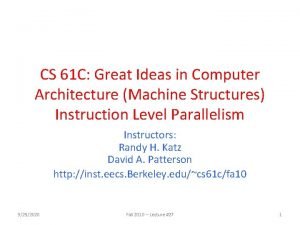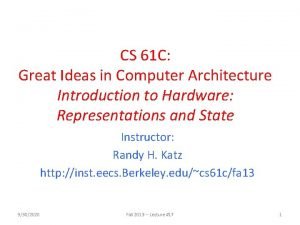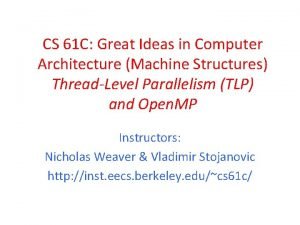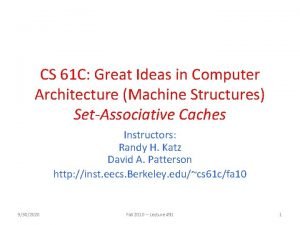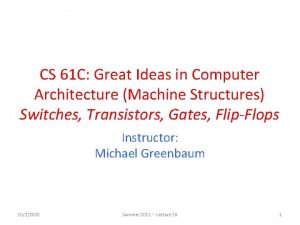CS 61 C Great Ideas in Computer Architecture
























- Slides: 24

CS 61 C: Great Ideas in Computer Architecture Dependability – More on ECC, RAID Vladimir Stojanovic & Nicholas Weaver http: //inst. eecs. berkeley. edu/~cs 61 c/ 1

Hamming Distance: 8 code words 2

Hamming Distance 2: Detection Detect Single Bit Errors Invalid Codewords • No 1 bit error goes to another valid codeword • ½ codewords are valid 3

Hamming Distance 3: Correction Correct Single Bit Errors, Detect Double Bit Errors Nearest 111 (one 0) Nearest 000 (one 1) • No 2 bit error goes to another valid codeword; 1 bit error near • 1/4 codewords are valid 4

Hamming Error Correcting Code • Overhead involved in single error-correction code • Let p be total number of parity bits and d number of data bits in p + d bit word • If p error correction bits are to point to error bit (p + d cases) + indicate that no error exists (1 case), we need: 2 p >= p + d + 1, thus p >= log 2(p + d + 1) for large d, p approaches log 2(d) • 8 bits data => d = 8, 2 p >= p + 8 + 1 => p >= 4 • 16 b data => 5 b parity, 32 b data => 6 b parity, 64 b data => 7 b parity 5

Hamming Single-Error Correction, Double-Error Detection (SEC/DED) • Adding extra parity bit covering the entire word provides double error detection as well as single error correction 1 2 3 4 5 6 7 8 p 1 p 2 d 1 p 3 d 2 d 3 d 4 p 4 • Hamming parity bits H (p 1 p 2 p 3) are computed (even parity as usual) plus the even parity over the entire word, p 4: H=0 p 4=0, no error H≠ 0 p 4=1, correctable single error (odd parity if 1 error => p 4=1) H≠ 0 p 4=0, double error occurred (even parity if 2 errors=> p 4=0) H=0 p 4=1, single error occurred in p 4 bit, not in rest of word Typical modern codes in DRAM memory systems: 64 -bit data blocks (8 bytes) with 72 -bit code words (9 bytes). 6

Hamming Single Error Correction + Double Error Detection 1 bit error (one 1) Nearest 0000 Hamming Distance = 4 1 bit error (one 0) Nearest 1111 2 bit error (two 0 s, two 1 s) Halfway Between Both 7

i. Clicker Question The following word is received, encoded with Hamming code: 0110001 What is the corrected data bit sequence? A. B. C. D. E. 1111 0001 1101 1011 1000 8

What if More Than 2 -Bit Errors? • Network transmissions, disks, distributed storage common failure mode is bursts of bit errors, not just one or two bit errors – Contiguous sequence of B bits in which first, last and any number of intermediate bits are in error – Caused by impulse noise or by fading in wireless – Effect is greater at higher data rates • Solve with Cyclic Redundancy Check (CRC), interleaving or other more advanced codes 9

i. Clicker Question The following word is received, encoded with Hamming code: 0110001 check p 1: 0 x 1 x 0 x 1 – o. k. check p 2: x 1 1 x x 0 1 – error in p 2 check p 4: x x x 0 0 0 1 – error in p 4 Error in location 2+4 =6 Correct data: 1 0 1 1 (answer D) 10

Evolution of the Disk Drive IBM 3390 K, 1986 IBM RAMAC 305, 1956 Apple SCSI, 1986 11

Arrays of Small Disks Can smaller disks be used to close gap in performance between disks and CPUs? Conventional: 4 disk designs 3. 5” 5. 25” Low End 10” 14” High End Disk Array: 1 disk design 3. 5” 12

Replace Small Number of Large Disks with Large Number of Small Disks! (1988 Disks) Capacity Volume Power Data Rate I/O Rate MTTF Cost IBM 3390 K 20 GBytes 97 cu. ft. 3 KW 15 MB/s 600 I/Os/s 250 KHrs $250 K IBM 3. 5" 0061 320 MBytes 0. 1 cu. ft. 11 W 1. 5 MB/s 55 I/Os/s 50 KHrs $2 K x 70 23 GBytes 11 cu. ft. 1 KW 120 MB/s 3900 IOs/s ? ? ? Hrs $150 K Disk Arrays have potential for large data and I/O rates, high MB per cu. ft. , high MB per KW, but what about reliability? 9 X 3 X 8 X 6 X 13

RAID: Redundant Arrays of (Inexpensive) Disks • Files are "striped" across multiple disks • Redundancy yields high data availability – Availability: service still provided to user, even if some components failed • Disks will still fail • Contents reconstructed from data redundantly stored in the array �Capacity penalty to store redundant info �Bandwidth penalty to update redundant info 14

Redundant Arrays of Inexpensive Disks RAID 1: Disk Mirroring/Shadowing recovery group • Each disk is fully duplicated onto its “mirror” Very high availability can be achieved • Writes limited by single-disk speed • Reads may be optimized Most expensive solution: 100% capacity overhead 15

Redundant Array of Inexpensive Disks RAID 3: Parity Disk 10010011 11001101 10010011. . . logical record Striped physical records P 1 0 0 0 1 1 P contains sum of other disks per stripe mod 2 (“parity”) If disk fails, subtract P from sum of other disks to find missing information 1 1 0 0 1 1 0 1 0 0 0 1 16

Redundant Arrays of Inexpensive Disks RAID 4: High I/O Rate Parity Insides of 5 disks Example: small read D 0 & D 5, large write D 12 D 15 D 0 D 1 D 2 D 3 P D 4 D 5 D 6 D 7 P D 8 D 9 D 10 D 11 P D 12 D 13 D 14 D 15 P D 16 D 17 D 18 D 19 P D 20 D 21 D 22 D 23 P . . . Disk. . Columns. . . Increasing Logical Disk Address Stripe . . . 17

Inspiration for RAID 5 • RAID 4 works well for small reads • Small writes (write to one disk): – Option 1: read other data disks, create new sum and write to Parity Disk – Option 2: since P has old sum, compare old data to new data, add the difference to P • Small writes are limited by Parity Disk: Write to D 0, D 5 both also write to P disk D 0 D 1 D 2 D 3 P D 4 D 5 D 6 D 7 P 18

RAID 5: High I/O Rate Interleaved Parity Independent writes possible because of interleaved parity Example: write to D 0, D 5 uses disks 0, 1, 3, 4 D 0 D 1 D 2 D 3 P D 4 D 5 D 6 P D 7 D 8 D 9 P D 10 D 11 D 12 P D 13 D 14 D 15 P D 16 D 17 D 18 D 19 D 20 D 21 D 22 D 23 P . . . . Disk Columns. . . . Increasing Logical Disk Addresses 19

Problems of Disk Arrays: Small Writes RAID-5: Small Write Algorithm 1 Logical Write = 2 Physical Reads + 2 Physical Writes D 0' new data D 0 D 1 D 2 D 3 old data (1. Read) P old (2. Read) parity + XOR (3. Write) D 0' D 1 (4. Write) D 2 D 3 P' 20

Tech Report Read ‘Round the World (December 1987) 21

RAID-I • RAID-I (1989) – Consisted of a Sun 4/280 workstation with 128 MB of DRAM, four dual-string SCSI controllers, 28 5. 25 inch SCSI disks and specialized disk striping software 22

RAID II • 1990 -1993 • Early Network Attached Storage (NAS) System running a Log Structured File System (LFS) • Impact: – $25 Billion/year in 2002 – Over $150 Billion in RAID device sold since 1990 -2002 – 200+ RAID companies (at the peak) – Software RAID a standard component of modern OSs 23

And, in Conclusion, … • Memory – Hamming distance 2: Parity for Single Error Detect – Hamming distance 3: Single Error Correction Code + encode bit position of error • Treat disks like memory, except you know when a disk has failed—erasure makes parity an Error Correcting Code • RAID-2, -3, -4, -5: Interleaved data and parity 24
 8 great ideas of computer architecture
8 great ideas of computer architecture Task level parallelism
Task level parallelism Cs61c
Cs61c 8 great ideas in computer architecture
8 great ideas in computer architecture Great theoretical ideas in computer science
Great theoretical ideas in computer science Great ideas in theoretical computer science
Great ideas in theoretical computer science Great theoretical ideas in computer science
Great theoretical ideas in computer science Great ideas in computer science
Great ideas in computer science Cmu 15251
Cmu 15251 Great theoretical ideas in computer science
Great theoretical ideas in computer science Great theoretical ideas in computer science
Great theoretical ideas in computer science Great theoretical ideas in computer science
Great theoretical ideas in computer science Vocabularize
Vocabularize Great theoretical ideas in computer science
Great theoretical ideas in computer science Great theoretical ideas in computer science
Great theoretical ideas in computer science Bus architecture in computer architecture
Bus architecture in computer architecture Computer architecture and computer organization difference
Computer architecture and computer organization difference Basic computer organization
Basic computer organization Ideas have consequences bad ideas have victims
Ideas have consequences bad ideas have victims Ideas principales e ideas secundarias
Ideas principales e ideas secundarias China big idea
China big idea Turning great strategy into great performance
Turning great strategy into great performance Faces of south dakota
Faces of south dakota Great power comes with great responsibility
Great power comes with great responsibility Great white vs hammerhead size
Great white vs hammerhead size

